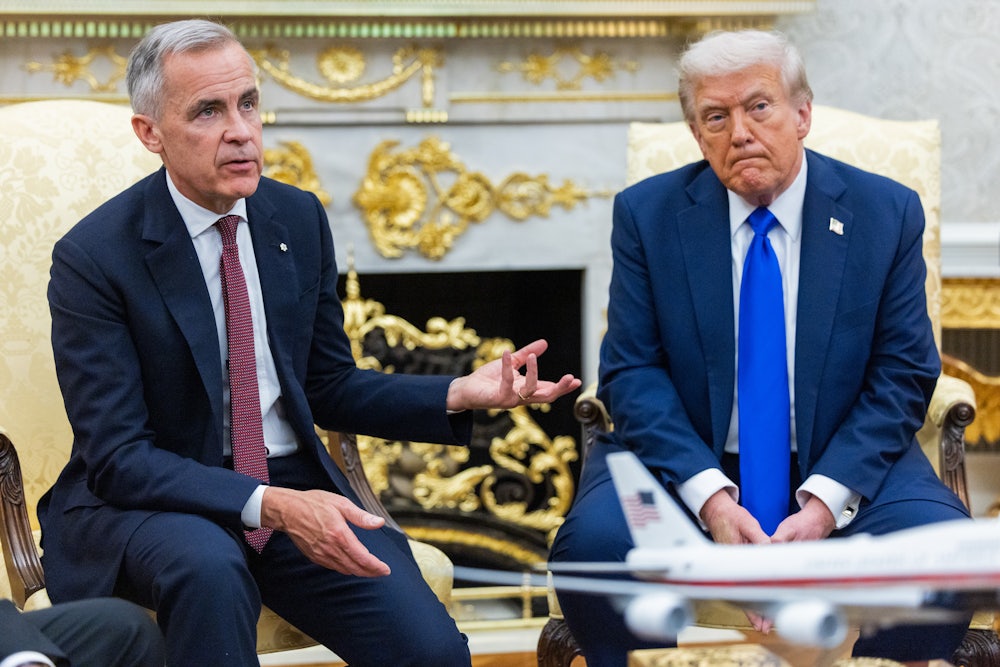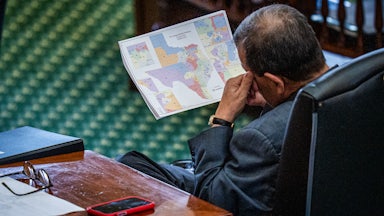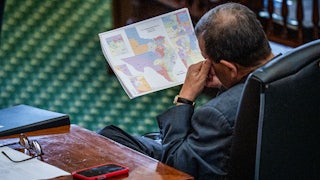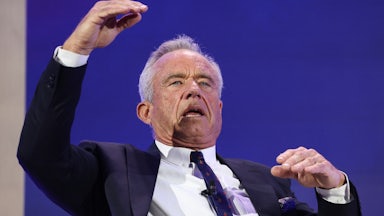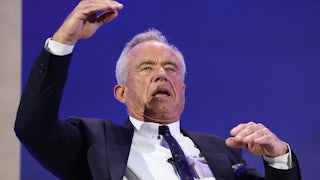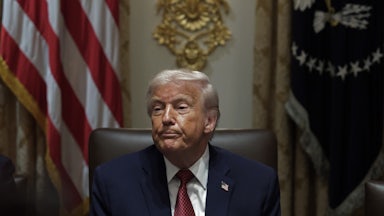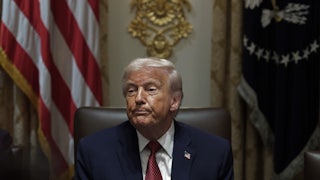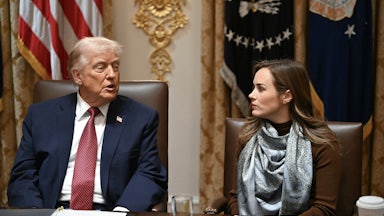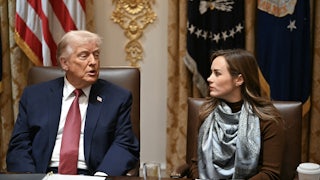Baseball fans who watched the World Series over the past week saw Addison Barger pinch-hit a grand slam to capture Game 1 for the Toronto Blue Jays and Yoshinobu Yamamoto retire 20 consecutive batters for a complete game to secure a Los Angeles Dodgers win in Game 2. In between those feats, they also witnessed a minor international incident.
The government of Ontario, one of Canada’s provinces, aired a commercial during the games that centered on a 1987 speech by then-President Ronald Reagan about trade policy. In the speech, Reagan condemns tariffs and other protectionist measures that restrict free trade and lower Americans’ quality of life.
“High tariffs inevitably lead to retaliation by foreign countries and the triggering of fierce trade wars,” Reagan said in the remarks. “The result is more and more tariffs, higher and higher trade barriers, and less and less competition. So, soon, because of the prices made artificially high by tariffs that subsidize inefficiency and poor management, people stop buying. Then the worst happens: Markets shrink and collapse; businesses and industries shut down; and millions of people lose their jobs.”
The ad was clearly meant as a critique of the Trump administration’s trade policy, and Trump—who gets reliably worked up any time the television isn’t nice to him—reacted accordingly. “The sole purpose of this FRAUD was Canada’s hope that the United States Supreme Court will come to their ‘rescue’ on Tariffs that they have used for years to hurt the United States,” he claimed on his personal social media website. “Now the United States is able to defend itself against high and overbearing Canadian Tariffs (and those from the rest of the World as well!).”
Trump also quoted from a statement by the Ronald Reagan Presidential Library that denounced the ad. “Their Advertisement was to be taken down, IMMEDIATELY, but they let it run last night during the World Series, knowing that it was a FRAUD,” Trump continued. “Because of their serious misrepresentation of the facts, and hostile act, I am increasing the Tariff on Canada by 10% over and above what they are paying now.”
Three things stand out about the president’s statement. One is the legal threats made by the Ronald Reagan Presidential Library and endorsed by Trump over the ad’s supposed misuse of Reagan’s remarks. As the Associated Press noted over the weekend, Reagan did occasionally levy import taxes on countries like Japan and on products like semiconductors, in response to foreign trade policies, but did not “love” tariffs as Trump claimed.
The Ronald Reagan Presidential Library doesn’t have any “legal options,” as its statement suggested. The library is a museum and archive, not some extension of his now-deceased person. It can’t sue Canada for defamation on someone else’s behalf, or for a dead person, or for something that is objectively true. Reagan really did give that speech and say those words and have those policies. Indeed, if I were a member of the Reagan family, I might be a little annoyed that a presidential library seems more interested in placating a sitting president than honestly representing its namesake’s legacy.
Another thing that stands out is Trump’s reference to the Supreme Court. His stated fear is that the advertisement could influence the justices. Oral arguments in the tariffs case are scheduled for November 5, and their outcome is clearly on the president’s mind. (He even threatened to attend in person.) But the ad made no mention of the court itself, nor did it appear to be directed toward the justices.
If influencing the justices was Ontario’s goal, it was a poorly planned effort. The ads did not air during the Yankees’ now-finished postseason run, where lifelong fan (and 1995 season savior) Sonia Sotomayor might have seen them. Nor did they appear when the Dodgers trounced Samuel Alito’s beloved Philadelphia Phillies in the divisional round. Neither Elena Kagan’s Mets nor the Washington Nationals, whose fans include Neil Gorsuch and Brett Kavanaugh, even made it to the postseason. (I do not believe any of the other four justices are Dodgers or Blue Jays fans, though they are free to request a correction via email.)
It is also not illegal or improper to air commercials with the hope of influencing Supreme Court justices. Nobody does it because it would be absurd and extremely inefficient; there is no way to guarantee that anyone on the court will be watching TV when your hopeful spot airs. If Ontario officials wanted to be sure that they had the justices’ ears, they’d have done better to file a friend-of-the-court brief in the current case. Foreign governments have done so in previous cases with international implications. None have been filed yet in in the tariffs case, likely because it would prompt the sort of backlash from Trump that we are witnessing now.
If nothing else, Trump’s mention of the Supreme Court would seem to betray a churning sense of concern that the justices might rule against him. That would be a seismic blow for his administration: Trump’s domestic economic agenda is built on the premise that he can impose trillions of dollars in tariffs on imported goods to punish foreign trade practices, stimulate domestic manufacturing, and raise revenues for the federal government.
Without that freewheeling power, Trump would have to rely on Congress to pass new tariffs as he cajoles, bullies, threatens, and occasionally negotiates with foreign governments over new trade deals, which would be a near-fatal obstacle. The White House apparently began recognizing the possibility that it could lose these legal challenges when it sent an unusual series of letters to the Federal Circuit Court of Appeals in August warning of a second Great Depression if it ruled against him. (The court did rule against him, and economic collapse did not follow.)
The most important thing about the ad is Trump’s response to it. Imposing an additional 10 percent tariff on Canadian goods because one of their provinces ran an ad during the World Series demolishes the legal justifications for Trump’s tariff policy. The Trump administration’s first wave of tariffs—the ones challenged by the plaintiffs in Learning Resources v. Trump—came after Trump issued declarations of national emergency about various harms that the tariffs would supposedly remedy.
Trump’s claimed authority comes from the International Emergency Economic Powers Act, or IEEPA, of 1977, a Cold War–era law that sought to clarify and harmonize certain trade-related powers that presidents could wield at Congress’s behest. After declaring a national emergency, the president can take a wide range of actions on foreign trade, investment, currency exchanges, and so on. That includes the power to “regulate importation[s].”
What counts as a national emergency is up to the president’s discretion. In its brief for the Supreme Court, for example, the Justice Department told the justices that “the President, in his exercise of power over the military and foreign affairs, has determined [they] are necessary to rectify America’s country-killing trade deficits and to stem the flood of fentanyl and other lethal drugs across our borders.” It is unclear how raising prices on Canadian lumber and steel would affect, let alone reduce, illegal drug smuggling.
Trump has played fast and loose with these national security justifications before. In a memorable exchange during his first term, then–Canadian Prime Minister Justin Trudeau reportedly asked the president what national security threat Canada could possibly pose to justify his imposition of IEEPA tariffs on Canadian steel and aluminum. According to CNN, Trump replied, “Didn’t you guys burn down the White House?”—an apparent reference to the War of 1812.
This is not to say that fentanyl isn’t a dangerous threat to American life or that an increase in domestic manufacturing capacity would be bad for the country. The problem is that tariffs don’t really address those problems while imposing severe economic consequences on Americans along the way. The Trump administration nevertheless insists that its judgment on what counts as a national emergency cannot be second-guessed by the courts.
“The president’s determinations in this area are not amenable to judicial review,” the Justice Department insisted. “Judges lack the institutional competence to determine when foreign affairs pose an unusual and extraordinary threat that requires an emergency response; that is a task for the political branches.” This is not incorrect; courts have historically given broad deference to the other two branches on foreign policy matters for that exact reason.
What Trump is asking the court to agree to goes beyond the ordinary judicial discomfort toward meddling in diplomatic matters. Raising tariffs on Canadian imports—to be more clear, raising import taxes on Americans—because a provincial government ran a commercial during the World Series that embarrassed the president is not a national emergency. If it is one, then anything can be a national emergency. This article could be a national emergency for criticizing the president, as well. (Fortunately I do not import any raw or finished goods into the United States, so I am beyond IEEPA’s scope.)
If it is willing to do so, the Supreme Court could easily end the tariff madness—and its ever-escalating costs to ordinary Americans. The justices could hold that the power to “regulate importations” does not extend to tariffs, which are a core Article 1 power for Congress. The court could apply the “major questions” doctrine, which holds that Congress must “speak clearly” when writing laws of “vast economic and political significance,” to rule that IEEPA does not allow presidents to impose trillions of dollars in tariffs on any country for any reason at all.
I do not expect the court to curb its historic reluctance to second-guess executive and legislative decisions on foreign policy. But it would not hurt if at least some of the justices noted, perhaps in a concurring opinion, that “deference” does not obligate the American judiciary to believe that up is down, or north is south, or that tariffs are paid by foreign countries, or that the president’s personal sense of embarrassment amounts to a national emergency. Chief Justice John Roberts famously once said that the court’s job was akin to that of an umpire who calls “balls and strikes.” That should also mean not calling a touchdown just because the president claims he scored one.
